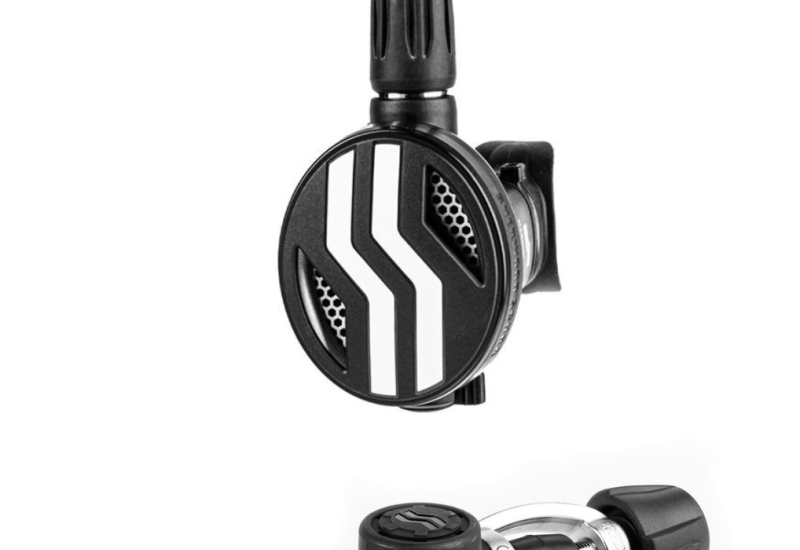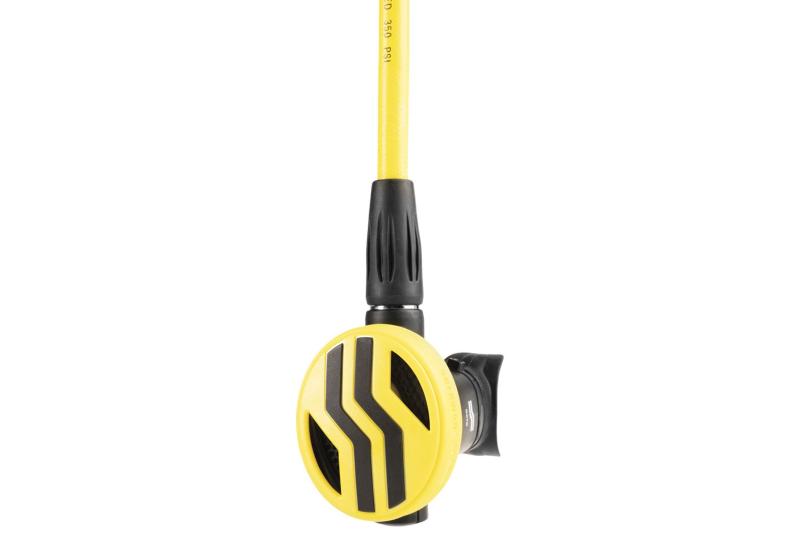16 Best New Regulators Over $400
April 2001
By Jon Hardy
Regulators Reviewed in This Article
| Dacor Viper America Genesis Scuba GS-2000 Genesis Scuba OZ Titanium Mares MR12 Orbiter Mares V16 Epos Mares V16 Orbiter Oceanic CDX Delta 3 Oceanic DX4 Delta 3 Oceanic PX2 Delta 3 | Poseidon Triton 2000 Scubapro MK16 S550 Scubapro MK20 S550 Scubapro MK20UL S600 SeaQuest Apeks TX50 SeaQuest Apeks TX100 Zeagle ZX DS-IV Zeagle ZX 50D |
||
|---|
|

|
Good news for consumers the regulators tested here have the highest overall performance of any group we have ever tested. Sixteen out of 17 rate as Tester's Choices, and eight of them also earned Best Buy awards.
-
Make sure you receive complete instructions, both oral and written, on how to use and care for your new regulator.
-
Add any components needed to complete your system, such as instruments, inflator hoses, alternate regulators and strain relief on hoses.
-
Check hose length at the store and make sure that the store will make any necessary changes that become apparent after you dive.
-
Check the comfort and fit of the mouthpiece and change it if necessary, or make sure that the store will change it after you've tried it in the water.
-
Make sure the dust cap is made of solid rubber, or solid plastic with an O-ring, and is securely attached to the regulator.
-
Have the store technician check the regulator on the store's flow bench and, if necessary, adjust to specifications without any leaking.
-
Have the technician remove all hoses and port plugs and make sure all threads are clear, all O-rings are installed, cleaned and lubed, and that there is no metal debris from the manufacturing process inside the ports, and then securely replace all hoses and plugs.
But all is not perfect. There is still room for improvement in the ergonomics of regulator function. In general, bubble interference, user adjustments and comfort need more attention by manufacturers.
Laboratory Tests
All 17 regulators were first checked to ensure they functioned correctly and operated within specifications. Next, at two engineering labs, each regulator was tested on a computer-controlled breathing simulator to stress it to extremes under controlled conditions. The results were then compared to those of all other regulators in this test group. U.S. Navy and European (CE) standards were used to evaluate performance. After hundreds of tests, scoring was based on the following four criteria:
1) Work of Breathing at 99 feet. The U.S. Navy standard test was run at this depth to establish a baseline for performance. All regulators should have passed this with ease, but one did not.
2) Work of Breathing at 198 feet. This is the Navy's standard test, with a supply pressure of 1,500 psi, a breathing rate of 25 breaths per minute and volume of 2.5 liters per breath. This is expressed in joules per liter with the maximum allowed 1.4 j/l. Amazingly, all but one regulator in this group passed this test with ease.
3) Loss of Performance from 99 to 198 feet. If a regulator's performance changes very little with increasing depth, it will be more stable and far easier to use.
4) Positive Pressure Breathing at 165 feet. Positive pressure breathing occurs when a regulator delivers more air than is demanded by the diver the regulator forces air into the diver's mouth. This is an unnatural way to breathe and may cause the regulator to be less stable, leading to leaks, free flows and possible harm to the diver, although this has not been proven. We used the CE criteria for the cutoff point. The perfect regulator would hold a steady, low work of breathing with little or no positive pressure and little or no loss of performance with increasing depth or decreasing supply pressure.
Ocean Testing
1) Bubble Interference. When looking down, straight ahead, up at a 45-degree angle and straight up, do the bubbles rise into the diver's field of view?
2) Adjustments. If the regulator has diver-controlled adjustments, how easy are they to find, grip and turn? Do they do their job in a reasonable manner?
3) Ease of Clearing. How difficult is it to find and use the purge? How dry is it after being cleared? How forceful is the purge? How much force does it take to clear by blowing?
4) Differing Positions. With the diver in a head-down or face-up horizontal position, how is breathing affected? Is it harder or easier? Wetter or dryer?
5) Ease of Breathing. How well does the regulator deliver air when the diver is swimming?
6) Wetness/Dryness. During normal swimming and when in odd positions, does the regulator breathe dry or wet?
7) Comfort. How comfortable is the mouthpiece? Hose length and stiffness? Buoyancy of the second stage? How does the second stage feel in the mouth?
Dealer Prep
Scuba regulators are high-tech life-support equipment that need professional attention right from the start. You wouldn't accept a new car without dealer prep, and you shouldn't accept a new regulator from a dive store without dealer prep.
All these regulators are new to Scuba Lab testing, although some may have been distributed under other names or been sold as a similar design.
The strengths and weaknesses listed for these regulators (indicated by thumbs-up and thumbs-down) are those aspects of performance that were rated significantly better or worse than the average for all regulators in this test group. All these manufacturers provide excellent owner's manuals.
Regulators in Review
Dacor Viper America ($440)
||
|---|
|

|
| Dacor Viper America|
First-stage type: Balanced diaphragm.Low-pressure ports: 4.High-pressure ports: 2.First-stage swivel? No.Second-stage adjustments: None.
THUMBS UP
- Outstanding breathing simulator performance
- Lack of bubble interference
- No vibration on exhale
THUMBS DOWN
- Weak, hard-to-use purge
- Comfort
The Viper is one of a small number of regulators with side exhaust. The advantages of side exhaust include that there is no right or left, nor up or down, so the primary hose can come from the right or left. Also, if you share air with another diver, either of you can use the second stage without changing positions, bending the hose or having the regulator end up upside-down. Another advantage is the greatly decreased bubble interference. In fact, a slight tilt of the head to the right completely eliminates bubble interference. The side exhaust also means the exhaled bubbles do not strike the second stage, and, therefore, there is no vibration on exhale.
The Viper's first stage has one low-pressure port labeled DFC (Dynamic Flow Control), which is designed to provide the best flow to your primary second stage. Having only one such port does limit options for hose positioning. The pivoting deflector in the second stage improves performance by aiming the air at your mouth on inhale and moving out of the way on exhale. When you clear the regulator, the deflector can move suddenly, making a popping sound. Although this problem still exists, it has been significantly lessened compared to previous models of the Viper.
The purge is hard to push and has a weak flow. Plus, when clearing the second stage by blowing, it helps to tilt your head to the left to be sure all the water is blown out. Comfort is somewhat lessened by hose stiffness and the negative buoyancy of the second stage.
Genesis Scuba GS-2000 ($425) & OZ Titanium ($995)
||
|---|
|

|
| Genesis Scuba Oz Titanium |
Genesis Scuba GS-2000 ($425)First-stage type: Balanced piston.Low-pressure ports: 4.High-pressure ports: 2.First-stage swivel? No.Second-stage adjustments: Dial and switch.
Genesis Scuba OZ Titanium ($995)
First-stage type: Balanced piston.
Low-pressure ports: 4.
High-pressure ports: 2.
First-stage swivel? No.
Second-stage adjustments: Dial and switch.
THUMBS UP
- Outstanding breathing simulator performance
- Breathing performance on human tests
- Comfort
THUMBS DOWN
- Bubble interference
- Vibration on exhale
The GS-2000 and the OZ Titanium are essentially the same outstanding regulator, but the OZ is made of titanium and comes nitrox-ready. Titanium is a lighter metal that resists corrosion better than other metals, and is also more expensive.
Unique to these Genesis regulators are the new Dry Air Demand (DAD) first stages, which are sealed, balanced flow-by pistons. With this system, the first stage is designed to allow no water to enter, therefore keeping salt, silt and sand out. This is done by supplying air pressure from inside the first stage to balance the external water or air pressure. Only during an ascent does the first stage vent a small amount of air.
As with most high-performance regulators, bubble interference was the weakest aspect of performance for these two regulators. Testers also did not care for the very small dive/pre-dive switches, which are not clearly labeled. The nearly neutral buoyancy of the second stages adds to the overall comfort of these regs.
With the OZ Titanium, you save some weight and can expect less loss of performance between servicing and less frequent servicing.
Mares MR12 Orbiter ($469), V16 Epos ($409) &V16 Orbiter ($534)
||
|---|
|

|
| Mares V16 Orbiter|
Mares MR12 Orbiter ($469)First-stage type: Balanced diaphragm.Low-pressure ports: 5.High-pressure ports: 1.First-stage swivel? No.Second-stage adjustments: None.
-
DFC. Dynamic Flow Control minimizes the intermediate pressure drop from the first to the second stage. It works as claimed, but is available on only one of the low-pressure ports, therefore limiting the placement of the primary second stage hose.
-
VAD. Vortex Assisted Design is a second-stage bypass that improves flow without excessive positive-pressure breathing or the need for user adjustments, yet keeps the regulator stable without leaks or free flows.
-
Pivoting Deflector. This is a new concept (only on the Epos) that helps to aim the flow of air in the second stage. On inhale, it aims the venturi at the mouth opening and moves out of the way on exhale.
-
Mesh grid. This second-stage cover design disperses water flow around the second-stage diaphragm and reduces the likelihood of free flows.
Mares V16 Epos ($409)
First-stage type: Balanced diaphragm.
Low-pressure ports: 4.
High-pressure ports: 2.
First-stage swivel? No.
Second-stage adjustments: None.
Mares V16 Orbiter ($534)
First-stage type: Balanced diaphragm.
Low-pressure ports: 4.
High-pressure ports: 2.
First-stage swivel? No.
Second-stage adjustments: None.
THUMBS UP
- Outstanding breathing simulator performance
- Breathing performance on human tests
- Easy-to-push purges on both Orbiters
THUMBS DOWN
- Bubble interference
- Comfort
Mares is a clear leader in high-performance regulators with balanced diaphragm first stages and non-adjustable second stages. This excellent stable performance is based on several proven design features, including:
Again, as with most high-performance regs, bubble interference is a weak aspect of these regulators' performance. Also, Mares regulators tend to be less comfortable due to the negatively buoyant second stages and stiff primary hoses.
Oceanic CDX Delta 3 ($399.95), Oceanic DX4 Delta 3 ($435.95) & Oceanic PX2 Delta 3 ($435.95)
||
|---|
|

|
| Oceanic PX2 Delta 3|
Oceanic CDX Delta 3 ($399.95)First-stage type: Balanced diaphragm.Low-pressure ports: 4.High-pressure ports: 2.First-stage swivel? No.Second-stage adjustments: Dial and switch.
Oceanic DX4 Delta 3 ($435.95)
First-stage type: Balanced diaphragm.
Low-pressure ports: 4.
High-pressure ports: 2.
First-stage swivel? No.
Second-stage adjustments: Dial and swicth.
Oceanic PX2 Delta 3 ($435.95)
First-stage type: Balanced piston.
Low-pressure ports: 4.
High-pressure ports: 2.
First-stage swivel? Yes.
Second-stage adjustments: Dial and switch.
THUMBS UP
- Outstanding breathing simulator performance
- Breathing performance on human tests
- Ease of clearing
- Dry breathing
THUMBS DOWN
- Bubble interference
- Vibration on exhale
These new regulators are the latest version of Oceanic's well-refined Delta series, now equipped with two user adjustments and three different first stage choices. High performance compared to modest pricing makes all three of these regulators Best Buys. Due to a recent price change, the CDX Delta 3 is actually a budget reg.
In addition to the outstanding performance scores on breathing, clearing and dryness, these regulators earned good scores for odd positions and comfort. The nearly neutral buoyancy of the second stage helped the comfort scores. Bubble interference, vibration of the second stage on exhale and the small adjustment switch were the weaker aspects of the Delta second stages.
The swivel on the PX2 first stage provided for the best hose placement of these three regs. The DX4 first stage now has one low-pressure port labeled "R", which has a venturi assist for the best flow to the primary second stage.
Poseidon Triton 2000
||
|---|
|

|
| Poseidon Triton 2000|
First-stage type: Balanced diaphragm.Low-pressure ports: 4.High-pressure ports: 2.First-stage swivel? No.Second-stage adjustments: None.
THUMBS UP
- Easy-to-push purge
- Lack of bubble interference
- Performance in odd positions
- No vibrations on exhale
THUMBS DOWN
- Breathing performance on human tests
Poseidon is held in high regard by many tech divers, and one of the most frequently asked questions we get is "Why don't you test Poseidon regulators?" The answer is that they do not submit products for tests. So for these tests, we purchased one of Poseidon's new Triton 2000 regulators. Performance on the breathing simulator tests for the Triton 2000 was not outstanding, but it would be acceptable for a budget regulator. This reg, however, costs a great deal more than a budget reg.
The second stage is actually buoyant, but this did not appear to affect the comfort scores. The unique swivel design of the second stage reduced bubble interference and eliminated vibrations on exhale. And, as is true of side-exhaust regulators, the Triton has no right or left, nor up or down, so it shares those advantages of mounting either direction and ease of sharing air. Although the purge is easy to push, testers found it to be in an odd position and excessively forceful.
The Triton's weakest scores came on the in-water human breathing tests, with variations in the quality of breathing and a continuous small leak.
There is one low-pressure port labeled "R" for the primary second stage hose, which then limits hose placement. The Triton comes with a yoke connection that easily unscrews so it can be used with a DIN valve.
Scubapro MK16 S550 ($440), MK20 S550 ($520) & MK20UL S600 ($946)
||
|---|
|

|
| Scubapro MK20UL S600|
Scubapro MK16 S550 ($440)First-stage type: Balanced diaphragm.Low-pressure ports: 4.High-pressure ports: 1.First-stage swivel? No.Second-stage adjustments: Switch.
Scubapro MK20 S550 ($520)
First-stage type: Balanced piston.
Low-pressure ports: 5.
High-pressure ports: 2.
First-stage swivel? Yes.
Second-stage adjustments: Switch.
Scubapro MK20UL S600 ($946)
First-stage type: Balanced piston.
Low-pressure ports: 5.
High-pressure ports: 2.
First-stage swivel? Yes.
Second-stage adjustments: Dial and switch.
THUMBS UP
- Outstanding breathing simulator performance
- Breathing performance on human tests
- Extremely high flow rate from first to second stages
- Dry breathing
THUMBS DOWN
- Bubble interference
- Vibration on exhale
Scubapro continues to improve and refine its high-performance regulator line. Although we have tested these versions of the MK20 first stage before, the MK16 and all the second stages are new to our testing. On breathing simulator tests, these three regulators averaged 0.9 joules per liter at 198 feet, the best of any regulators. In fact, the S600 produced the best breathing machine score in the history of Scuba Lab at 0.8 joules per liter.
The MK20 first stages have more and better placement of their low-pressure ports than the MK16, although the MK16 does have two "High Flow Ports" providing more options in positioning the primary hose than are available on regulators made by other manufacturers.
The dive/pre-dive switch on these regulators, called a "VIVA," has the best labeling of any such device, but these switches are difficult to grip and turn. Bubble interference and vibrations on exhale are common among high-performance regulators and these regs are no exception. Keep in mind that you will not experience these when swimming normally under water; they only occur when you are not moving.
These second stages are very nearly neutrally buoyant, thus improving comfort. The reusable mouthpiece clamps rub against the lips of some divers, lessening comfort, but they can be easily replaced with tie wraps.
Scubapro provides its Thermal Insulating System (TIS) on all these regulators, thus providing added protection from freeze-ups in cold water. The MK20UL first stage is made of an aluminum alloy with a special ceramic-like coating, soft cover on the swivel section and gaskets used with the O-rings to prevent the port plugs from corroding in place. The UL first stage weighs more than one pound less than the brass MK20. There is no appreciable difference in performance between the aluminum and brass first stages.
SeaQuest Apeks TX50 ($500) & Apeks TX100 ($630)
||
|---|
|

|
| SeaQuest Apeks TX50|
SeaQuest Apeks TX50 ($500)First-stage type: Balanced diaphragm.Low-pressure ports: 4.High-pressure ports: 2.First-stage swivel? Yes.Second-stage adjustments: Dial and switch.
SeaQuest Apeks TX100 ($630)
First-stage type: Balanced diaphragm.
Low-pressure ports: 4.
High-pressure ports: 2.
First-stage swivel? No.
Second-stage adjustments: Dial and switch.
THUMBS UP
- Outstanding breathing simulator performance
- Breathing performance on human tests
- Easy to push purges
- Dry breathing
- Lack of bubble interference
The British company Apeks has been producing excellent high-performance regulators for some 25 years. Some of these have been distributed under other names, but now SeaQuest is distributing these high- quality regulators. Both of these regs use balanced diaphragms with a dry sealed system for the first stages.
Larger-than-average exhaust tees reduce the bubble interference common to most high-performance regulators. The dive/pre-dive switches are easier to use than most, but could still be better. The TX100 is among the best of regulators without a swivel in terms of placement of first-stage low-pressure ports. These regulators use the Comfo-Bite mouthpiece common to Aqua Lung and SeaQuest regulators. These mouthpieces allow you to relax your jaws and let the mouthpiece "float" in your mouth. Although these mouthpieces are gaining popularity, some divers are bothered by the part of the mouthpiece that can touch the roof of the mouth. It is, of course, easy to change mouthpieces. Both of these Apeks regulators are suitable for use in cold water.
Worthy of note is the fact that no aspect of performance for either of these regulators was below the average for this test group.
Zeagle ZX DS-IV ($469) & Zeagle ZX 50D ($529)
||
|---|
|

|
| Zeagle ZX 50D |
Zeagle ZX DS-IV ($469)First-stage type: Balanced diaphragm.Low-pressure ports: 4.High-pressure ports: 2.First-stage swivel? No.Second-stage adjustments: Dial and switch.
Zeagle ZX 50D ($529)
First-stage type: Balanced diaphragm.
Low-pressure ports: 4.
High-pressure ports: 2.
First-stage swivel? Yes.
Second-stage adjustments: Dial and switch.
THUMBS UP
- Outstanding breathing simulator performance
- Breathing performance on human tests
- Ease of clearing
THUMBS DOWN
- Bubble interference
These completely new models from Zeagle are two more outstanding regulators that have some features and appearance aspects that are common to many high-performance regulators. Both are sealed, balanced diaphragms with two user adjustments, four low-pressure ports and two high-pressure ports. The 50D also has a first-stage swivel.
The average breathing simulator performance at 198 feet for both regulators hovered just over 1 joule per liter, a remarkable performance for any regulator, let alone two completely new ones.
The second-stage user adjustments are very similar to those on the Apeks regulators, but need better labeling and smoother function. The purge cover is the entire face of the second stage and is, therefore, very easy to use. The bubble interference is typical of high-performance regulators. These regulators are well-suited for cold-water use.
For More Info
Dacor www.divedacor.com
Genesis Scuba www.genesisscuba.com
Mares www.htmsport.com
Oceanic www.oceanicww.com
Poseidon www.poseidon.se
Scubapro www.scubapro.com
SeaQuest www.sea-quest.com
Zeagle www.zeagle.com
April 2001
By Jon Hardy
Regulators Reviewed in This Article
||| |---|---|
| Dacor Viper America Genesis Scuba GS-2000 Genesis Scuba OZ Titanium Mares MR12 Orbiter Mares V16 Epos Mares V16 Orbiter Oceanic CDX Delta 3 Oceanic DX4 Delta 3 Oceanic PX2 Delta 3 | Poseidon Triton 2000 Scubapro MK16 S550 Scubapro MK20 S550 Scubapro MK20UL S600 SeaQuest Apeks TX50 SeaQuest Apeks TX100 Zeagle ZX DS-IV Zeagle ZX 50D ||| |---|
|
|
But all is not perfect. There is still room for improvement in the ergonomics of regulator function. In general, bubble interference, user adjustments and comfort need more attention by manufacturers.
Laboratory Tests
All 17 regulators were first checked to ensure they functioned correctly and operated within specifications. Next, at two engineering labs, each regulator was tested on a computer-controlled breathing simulator to stress it to extremes under controlled conditions. The results were then compared to those of all other regulators in this test group. U.S. Navy and European (CE) standards were used to evaluate performance. After hundreds of tests, scoring was based on the following four criteria:
1) Work of Breathing at 99 feet. The U.S. Navy standard test was run at this depth to establish a baseline for performance. All regulators should have passed this with ease, but one did not.
2) Work of Breathing at 198 feet. This is the Navy's standard test, with a supply pressure of 1,500 psi, a breathing rate of 25 breaths per minute and volume of 2.5 liters per breath. This is expressed in joules per liter with the maximum allowed 1.4 j/l. Amazingly, all but one regulator in this group passed this test with ease.
3) Loss of Performance from 99 to 198 feet. If a regulator's performance changes very little with increasing depth, it will be more stable and far easier to use.
4) Positive Pressure Breathing at 165 feet. Positive pressure breathing occurs when a regulator delivers more air than is demanded by the diver the regulator forces air into the diver's mouth. This is an unnatural way to breathe and may cause the regulator to be less stable, leading to leaks, free flows and possible harm to the diver, although this has not been proven. We used the CE criteria for the cutoff point. The perfect regulator would hold a steady, low work of breathing with little or no positive pressure and little or no loss of performance with increasing depth or decreasing supply pressure.
Ocean Testing
1) Bubble Interference. When looking down, straight ahead, up at a 45-degree angle and straight up, do the bubbles rise into the diver's field of view?
2) Adjustments. If the regulator has diver-controlled adjustments, how easy are they to find, grip and turn? Do they do their job in a reasonable manner?
3) Ease of Clearing. How difficult is it to find and use the purge? How dry is it after being cleared? How forceful is the purge? How much force does it take to clear by blowing?
4) Differing Positions. With the diver in a head-down or face-up horizontal position, how is breathing affected? Is it harder or easier? Wetter or dryer?
5) Ease of Breathing. How well does the regulator deliver air when the diver is swimming?
6) Wetness/Dryness. During normal swimming and when in odd positions, does the regulator breathe dry or wet?
7) Comfort. How comfortable is the mouthpiece? Hose length and stiffness? Buoyancy of the second stage? How does the second stage feel in the mouth?
Dealer Prep
Scuba regulators are high-tech life-support equipment that need professional attention right from the start. You wouldn't accept a new car without dealer prep, and you shouldn't accept a new regulator from a dive store without dealer prep.
Make sure you receive complete instructions, both oral and written, on how to use and care for your new regulator.
Add any components needed to complete your system, such as instruments, inflator hoses, alternate regulators and strain relief on hoses.
Check hose length at the store and make sure that the store will make any necessary changes that become apparent after you dive.
Check the comfort and fit of the mouthpiece and change it if necessary, or make sure that the store will change it after you've tried it in the water.
Make sure the dust cap is made of solid rubber, or solid plastic with an O-ring, and is securely attached to the regulator.
Have the store technician check the regulator on the store's flow bench and, if necessary, adjust to specifications without any leaking.
Have the technician remove all hoses and port plugs and make sure all threads are clear, all O-rings are installed, cleaned and lubed, and that there is no metal debris from the manufacturing process inside the ports, and then securely replace all hoses and plugs.
All these regulators are new to Scuba Lab testing, although some may have been distributed under other names or been sold as a similar design.
The strengths and weaknesses listed for these regulators (indicated by thumbs-up and thumbs-down) are those aspects of performance that were rated significantly better or worse than the average for all regulators in this test group. All these manufacturers provide excellent owner's manuals.
Regulators in Review
Dacor Viper America ($440)
|| |---|
|
| | Dacor Viper America|
Low-pressure ports: 4.
High-pressure ports: 2.
First-stage swivel? No.
Second-stage adjustments: None.
THUMBS UP
- Outstanding breathing simulator performance
- Lack of bubble interference
- No vibration on exhale
THUMBS DOWN
- Weak, hard-to-use purge
- Comfort
The Viper is one of a small number of regulators with side exhaust. The advantages of side exhaust include that there is no right or left, nor up or down, so the primary hose can come from the right or left. Also, if you share air with another diver, either of you can use the second stage without changing positions, bending the hose or having the regulator end up upside-down. Another advantage is the greatly decreased bubble interference. In fact, a slight tilt of the head to the right completely eliminates bubble interference. The side exhaust also means the exhaled bubbles do not strike the second stage, and, therefore, there is no vibration on exhale.
The Viper's first stage has one low-pressure port labeled DFC (Dynamic Flow Control), which is designed to provide the best flow to your primary second stage. Having only one such port does limit options for hose positioning. The pivoting deflector in the second stage improves performance by aiming the air at your mouth on inhale and moving out of the way on exhale. When you clear the regulator, the deflector can move suddenly, making a popping sound. Although this problem still exists, it has been significantly lessened compared to previous models of the Viper.
The purge is hard to push and has a weak flow. Plus, when clearing the second stage by blowing, it helps to tilt your head to the left to be sure all the water is blown out. Comfort is somewhat lessened by hose stiffness and the negative buoyancy of the second stage.
Genesis Scuba GS-2000 ($425) & OZ Titanium ($995)
|| |---|
|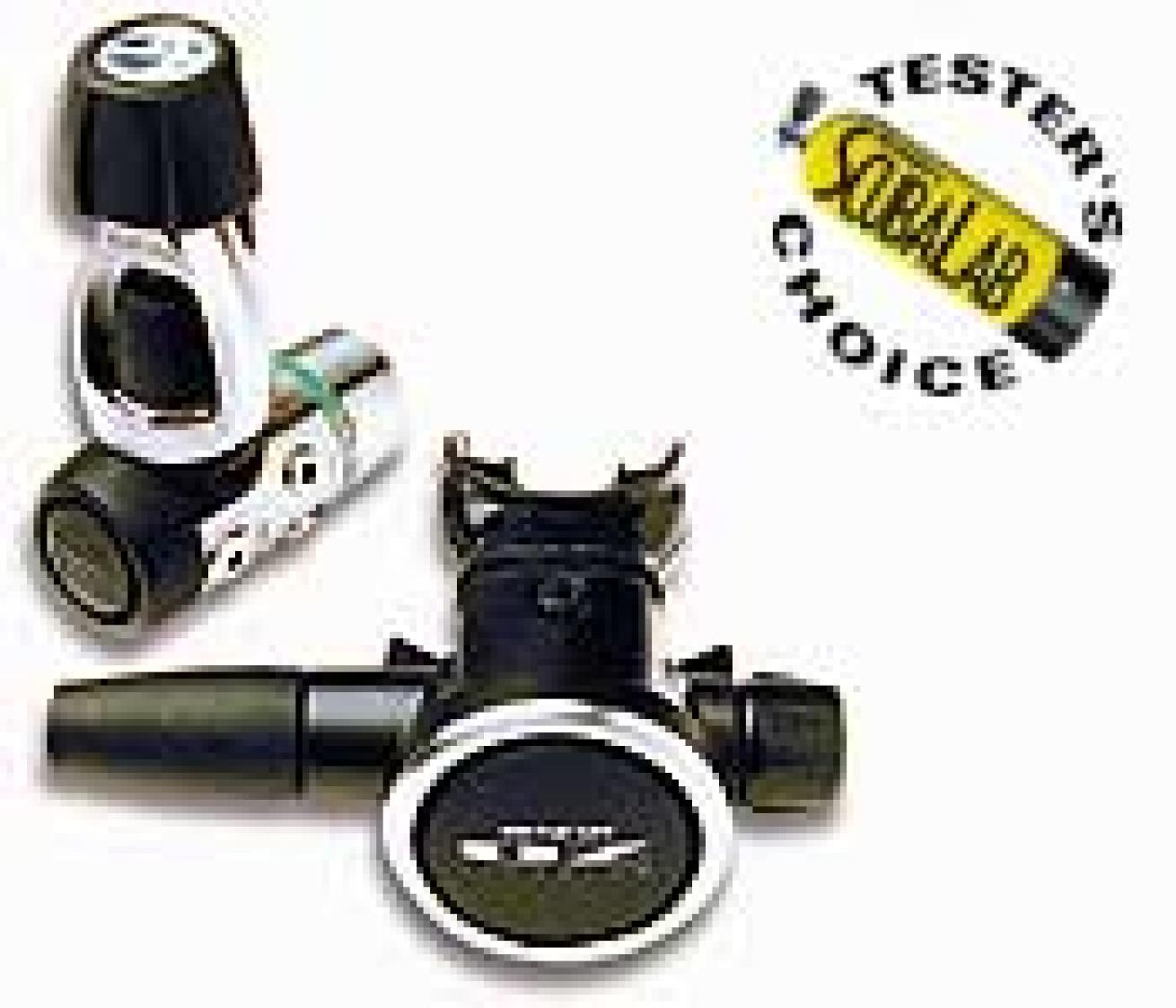
| | Genesis Scuba Oz Titanium |
First-stage type: Balanced piston.
Low-pressure ports: 4.
High-pressure ports: 2.
First-stage swivel? No.
Second-stage adjustments: Dial and switch.
Genesis Scuba OZ Titanium ($995)
First-stage type: Balanced piston.
Low-pressure ports: 4.
High-pressure ports: 2.
First-stage swivel? No.
Second-stage adjustments: Dial and switch.
THUMBS UP
- Outstanding breathing simulator performance
- Breathing performance on human tests
- Comfort
THUMBS DOWN
- Bubble interference
- Vibration on exhale
The GS-2000 and the OZ Titanium are essentially the same outstanding regulator, but the OZ is made of titanium and comes nitrox-ready. Titanium is a lighter metal that resists corrosion better than other metals, and is also more expensive.
Unique to these Genesis regulators are the new Dry Air Demand (DAD) first stages, which are sealed, balanced flow-by pistons. With this system, the first stage is designed to allow no water to enter, therefore keeping salt, silt and sand out. This is done by supplying air pressure from inside the first stage to balance the external water or air pressure. Only during an ascent does the first stage vent a small amount of air.
As with most high-performance regulators, bubble interference was the weakest aspect of performance for these two regulators. Testers also did not care for the very small dive/pre-dive switches, which are not clearly labeled. The nearly neutral buoyancy of the second stages adds to the overall comfort of these regs.
With the OZ Titanium, you save some weight and can expect less loss of performance between servicing and less frequent servicing.
Mares MR12 Orbiter ($469), V16 Epos ($409) &V16 Orbiter ($534)
|| |---|
|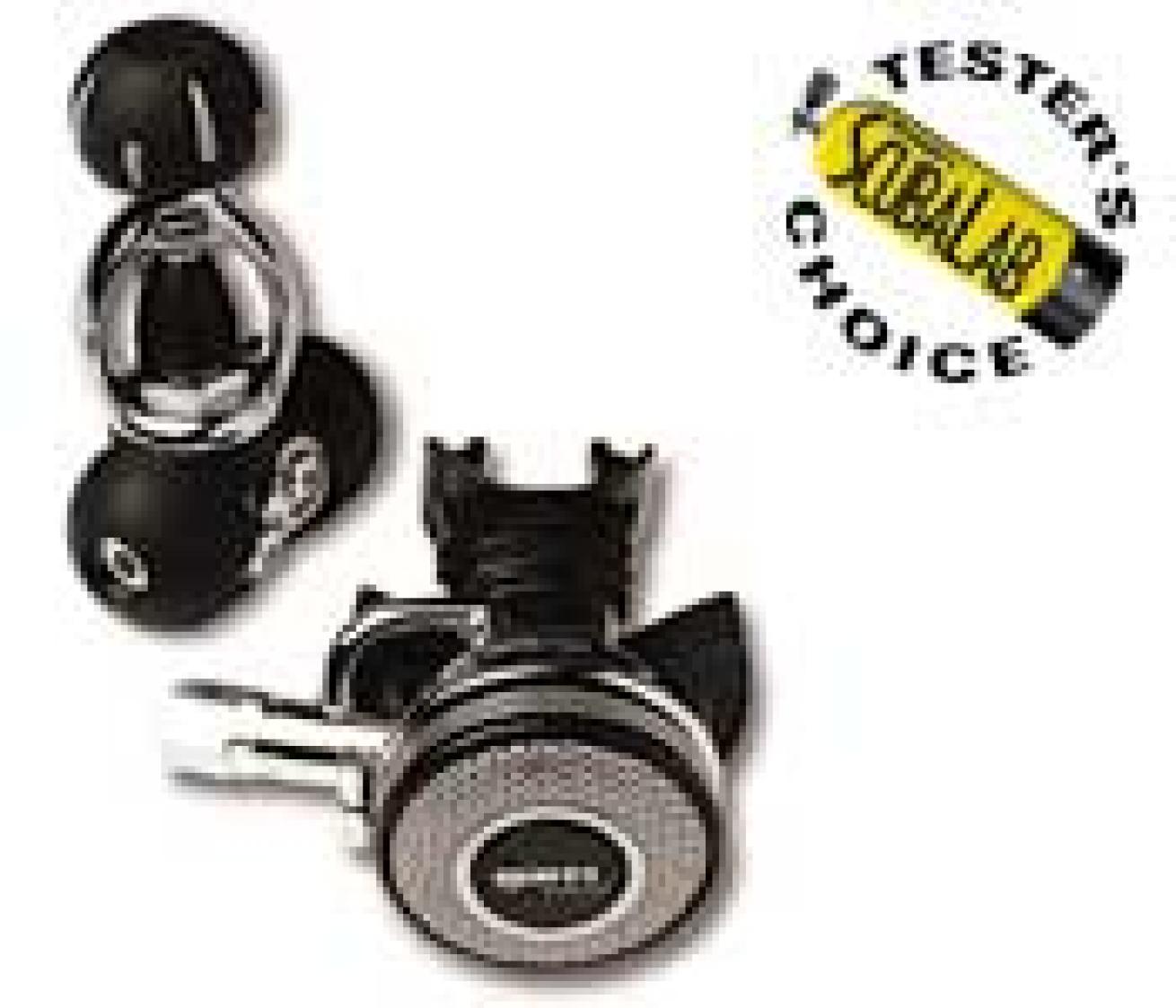
| | Mares V16 Orbiter|
First-stage type: Balanced diaphragm.
Low-pressure ports: 5.
High-pressure ports: 1.
First-stage swivel? No.
Second-stage adjustments: None.
Mares V16 Epos ($409)
First-stage type: Balanced diaphragm.
Low-pressure ports: 4.
High-pressure ports: 2.
First-stage swivel? No.
Second-stage adjustments: None.
Mares V16 Orbiter ($534)
First-stage type: Balanced diaphragm.
Low-pressure ports: 4.
High-pressure ports: 2.
First-stage swivel? No.
Second-stage adjustments: None.
THUMBS UP
- Outstanding breathing simulator performance
- Breathing performance on human tests
- Easy-to-push purges on both Orbiters
THUMBS DOWN
- Bubble interference
- Comfort
Mares is a clear leader in high-performance regulators with balanced diaphragm first stages and non-adjustable second stages. This excellent stable performance is based on several proven design features, including:
DFC. Dynamic Flow Control minimizes the intermediate pressure drop from the first to the second stage. It works as claimed, but is available on only one of the low-pressure ports, therefore limiting the placement of the primary second stage hose.
VAD. Vortex Assisted Design is a second-stage bypass that improves flow without excessive positive-pressure breathing or the need for user adjustments, yet keeps the regulator stable without leaks or free flows.
Pivoting Deflector. This is a new concept (only on the Epos) that helps to aim the flow of air in the second stage. On inhale, it aims the venturi at the mouth opening and moves out of the way on exhale.
Mesh grid. This second-stage cover design disperses water flow around the second-stage diaphragm and reduces the likelihood of free flows.
Again, as with most high-performance regs, bubble interference is a weak aspect of these regulators' performance. Also, Mares regulators tend to be less comfortable due to the negatively buoyant second stages and stiff primary hoses.
Oceanic CDX Delta 3 ($399.95), Oceanic DX4 Delta 3 ($435.95) & Oceanic PX2 Delta 3 ($435.95)
|| |---|
|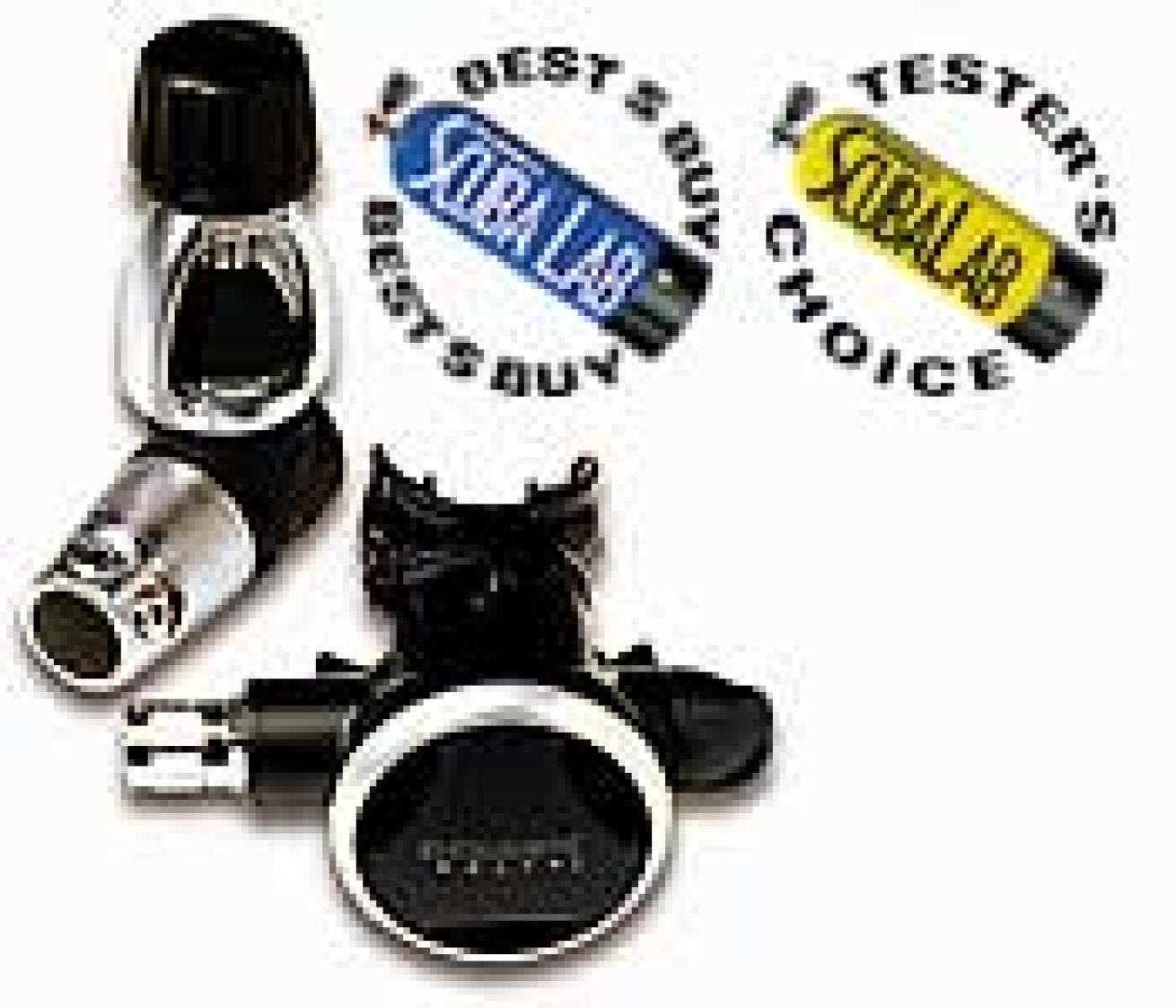
| | Oceanic PX2 Delta 3|
First-stage type: Balanced diaphragm.
Low-pressure ports: 4.
High-pressure ports: 2.
First-stage swivel? No.
Second-stage adjustments: Dial and switch.
Oceanic DX4 Delta 3 ($435.95)
First-stage type: Balanced diaphragm.
Low-pressure ports: 4.
High-pressure ports: 2.
First-stage swivel? No.
Second-stage adjustments: Dial and swicth.
Oceanic PX2 Delta 3 ($435.95)
First-stage type: Balanced piston.
Low-pressure ports: 4.
High-pressure ports: 2.
First-stage swivel? Yes.
Second-stage adjustments: Dial and switch.
THUMBS UP
- Outstanding breathing simulator performance
- Breathing performance on human tests
- Ease of clearing
- Dry breathing
THUMBS DOWN
- Bubble interference
- Vibration on exhale
These new regulators are the latest version of Oceanic's well-refined Delta series, now equipped with two user adjustments and three different first stage choices. High performance compared to modest pricing makes all three of these regulators Best Buys. Due to a recent price change, the CDX Delta 3 is actually a budget reg.
In addition to the outstanding performance scores on breathing, clearing and dryness, these regulators earned good scores for odd positions and comfort. The nearly neutral buoyancy of the second stage helped the comfort scores. Bubble interference, vibration of the second stage on exhale and the small adjustment switch were the weaker aspects of the Delta second stages.
The swivel on the PX2 first stage provided for the best hose placement of these three regs. The DX4 first stage now has one low-pressure port labeled "R", which has a venturi assist for the best flow to the primary second stage.
Poseidon Triton 2000
|| |---|
|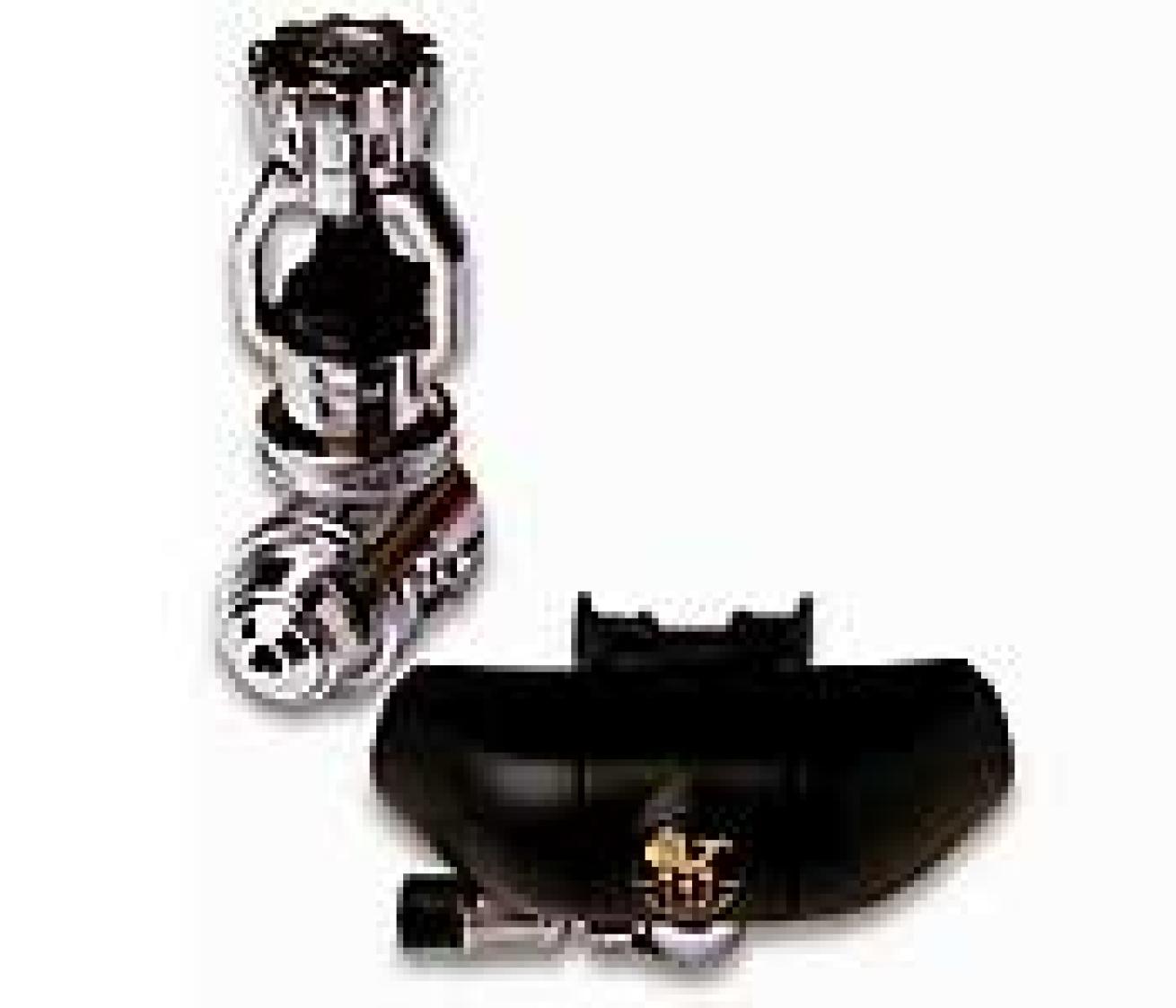
| | Poseidon Triton 2000|
Low-pressure ports: 4.
High-pressure ports: 2.
First-stage swivel? No.
Second-stage adjustments: None.
THUMBS UP
- Easy-to-push purge
- Lack of bubble interference
- Performance in odd positions
- No vibrations on exhale
THUMBS DOWN
- Breathing performance on human tests
Poseidon is held in high regard by many tech divers, and one of the most frequently asked questions we get is "Why don't you test Poseidon regulators?" The answer is that they do not submit products for tests. So for these tests, we purchased one of Poseidon's new Triton 2000 regulators. Performance on the breathing simulator tests for the Triton 2000 was not outstanding, but it would be acceptable for a budget regulator. This reg, however, costs a great deal more than a budget reg.
The second stage is actually buoyant, but this did not appear to affect the comfort scores. The unique swivel design of the second stage reduced bubble interference and eliminated vibrations on exhale. And, as is true of side-exhaust regulators, the Triton has no right or left, nor up or down, so it shares those advantages of mounting either direction and ease of sharing air. Although the purge is easy to push, testers found it to be in an odd position and excessively forceful.
The Triton's weakest scores came on the in-water human breathing tests, with variations in the quality of breathing and a continuous small leak.
There is one low-pressure port labeled "R" for the primary second stage hose, which then limits hose placement. The Triton comes with a yoke connection that easily unscrews so it can be used with a DIN valve.
Scubapro MK16 S550 ($440), MK20 S550 ($520) & MK20UL S600 ($946)
|| |---|
|
| | Scubapro MK20UL S600|
First-stage type: Balanced diaphragm.
Low-pressure ports: 4.
High-pressure ports: 1.
First-stage swivel? No.
Second-stage adjustments: Switch.
Scubapro MK20 S550 ($520)
First-stage type: Balanced piston.
Low-pressure ports: 5.
High-pressure ports: 2.
First-stage swivel? Yes.
Second-stage adjustments: Switch.
Scubapro MK20UL S600 ($946)
First-stage type: Balanced piston.
Low-pressure ports: 5.
High-pressure ports: 2.
First-stage swivel? Yes.
Second-stage adjustments: Dial and switch.
THUMBS UP
- Outstanding breathing simulator performance
- Breathing performance on human tests
- Extremely high flow rate from first to second stages
- Dry breathing
THUMBS DOWN
- Bubble interference
- Vibration on exhale
Scubapro continues to improve and refine its high-performance regulator line. Although we have tested these versions of the MK20 first stage before, the MK16 and all the second stages are new to our testing. On breathing simulator tests, these three regulators averaged 0.9 joules per liter at 198 feet, the best of any regulators. In fact, the S600 produced the best breathing machine score in the history of Scuba Lab at 0.8 joules per liter.
The MK20 first stages have more and better placement of their low-pressure ports than the MK16, although the MK16 does have two "High Flow Ports" providing more options in positioning the primary hose than are available on regulators made by other manufacturers.
The dive/pre-dive switch on these regulators, called a "VIVA," has the best labeling of any such device, but these switches are difficult to grip and turn. Bubble interference and vibrations on exhale are common among high-performance regulators and these regs are no exception. Keep in mind that you will not experience these when swimming normally under water; they only occur when you are not moving.
These second stages are very nearly neutrally buoyant, thus improving comfort. The reusable mouthpiece clamps rub against the lips of some divers, lessening comfort, but they can be easily replaced with tie wraps.
Scubapro provides its Thermal Insulating System (TIS) on all these regulators, thus providing added protection from freeze-ups in cold water. The MK20UL first stage is made of an aluminum alloy with a special ceramic-like coating, soft cover on the swivel section and gaskets used with the O-rings to prevent the port plugs from corroding in place. The UL first stage weighs more than one pound less than the brass MK20. There is no appreciable difference in performance between the aluminum and brass first stages.
SeaQuest Apeks TX50 ($500) & Apeks TX100 ($630)
|| |---|
|
| | SeaQuest Apeks TX50|
First-stage type: Balanced diaphragm.
Low-pressure ports: 4.
High-pressure ports: 2.
First-stage swivel? Yes.
Second-stage adjustments: Dial and switch.
SeaQuest Apeks TX100 ($630)
First-stage type: Balanced diaphragm.
Low-pressure ports: 4.
High-pressure ports: 2.
First-stage swivel? No.
Second-stage adjustments: Dial and switch.
THUMBS UP
- Outstanding breathing simulator performance
- Breathing performance on human tests
- Easy to push purges
- Dry breathing
- Lack of bubble interference
The British company Apeks has been producing excellent high-performance regulators for some 25 years. Some of these have been distributed under other names, but now SeaQuest is distributing these high- quality regulators. Both of these regs use balanced diaphragms with a dry sealed system for the first stages.
Larger-than-average exhaust tees reduce the bubble interference common to most high-performance regulators. The dive/pre-dive switches are easier to use than most, but could still be better. The TX100 is among the best of regulators without a swivel in terms of placement of first-stage low-pressure ports. These regulators use the Comfo-Bite mouthpiece common to Aqua Lung and SeaQuest regulators. These mouthpieces allow you to relax your jaws and let the mouthpiece "float" in your mouth. Although these mouthpieces are gaining popularity, some divers are bothered by the part of the mouthpiece that can touch the roof of the mouth. It is, of course, easy to change mouthpieces. Both of these Apeks regulators are suitable for use in cold water.
Worthy of note is the fact that no aspect of performance for either of these regulators was below the average for this test group.
Zeagle ZX DS-IV ($469) & Zeagle ZX 50D ($529)
|| |---|
|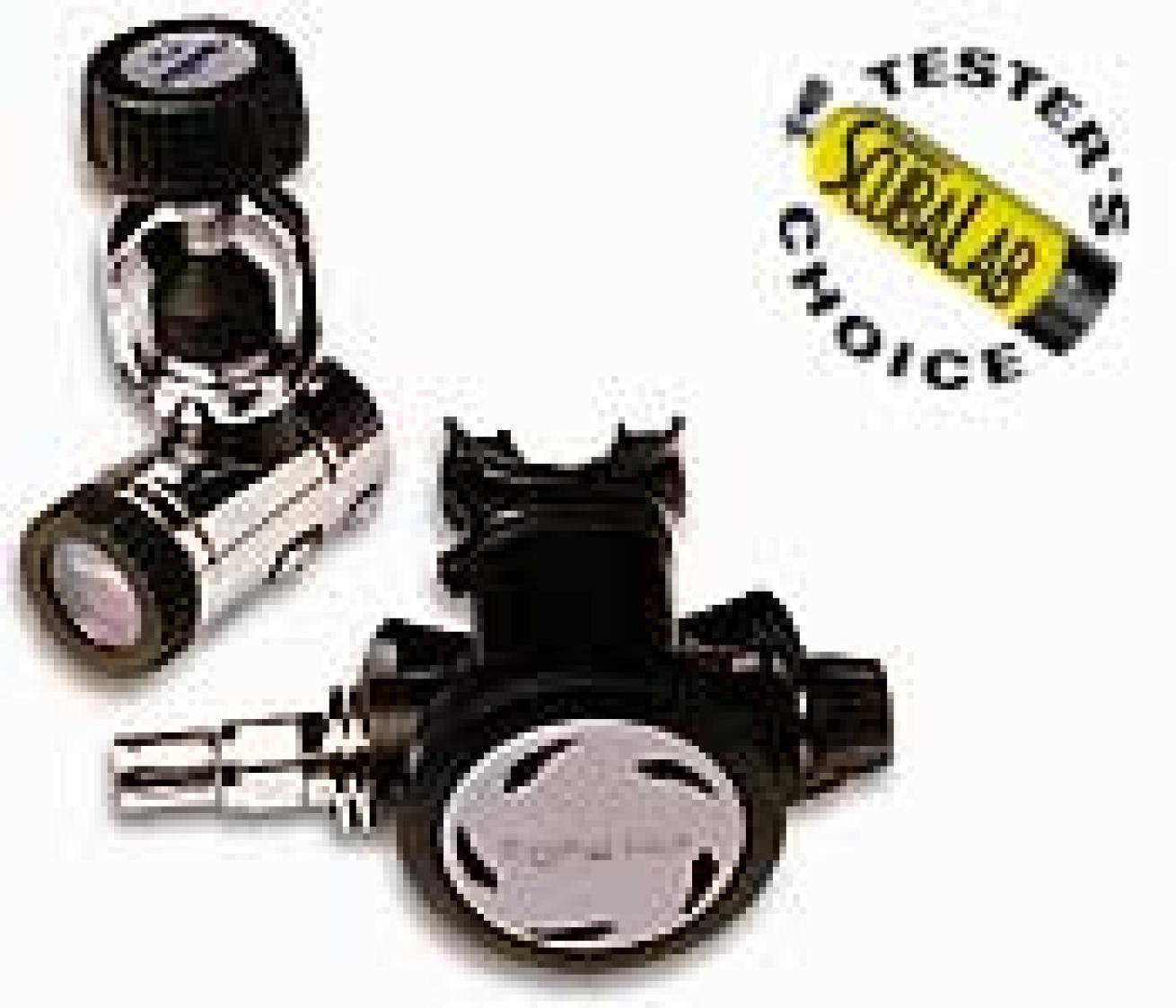
| | Zeagle ZX 50D |
First-stage type: Balanced diaphragm.
Low-pressure ports: 4.
High-pressure ports: 2.
First-stage swivel? No.
Second-stage adjustments: Dial and switch.
Zeagle ZX 50D ($529)
First-stage type: Balanced diaphragm.
Low-pressure ports: 4.
High-pressure ports: 2.
First-stage swivel? Yes.
Second-stage adjustments: Dial and switch.
THUMBS UP
- Outstanding breathing simulator performance
- Breathing performance on human tests
- Ease of clearing
THUMBS DOWN
- Bubble interference
These completely new models from Zeagle are two more outstanding regulators that have some features and appearance aspects that are common to many high-performance regulators. Both are sealed, balanced diaphragms with two user adjustments, four low-pressure ports and two high-pressure ports. The 50D also has a first-stage swivel.
The average breathing simulator performance at 198 feet for both regulators hovered just over 1 joule per liter, a remarkable performance for any regulator, let alone two completely new ones.
The second-stage user adjustments are very similar to those on the Apeks regulators, but need better labeling and smoother function. The purge cover is the entire face of the second stage and is, therefore, very easy to use. The bubble interference is typical of high-performance regulators. These regulators are well-suited for cold-water use.
For More Info
Dacor www.divedacor.com
Genesis Scuba www.genesisscuba.com
Mares www.htmsport.com
Oceanic www.oceanicww.com
Poseidon www.poseidon.se
Scubapro www.scubapro.com
SeaQuest www.sea-quest.com
Zeagle www.zeagle.com

